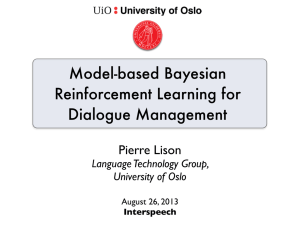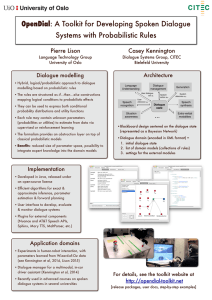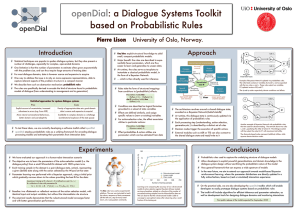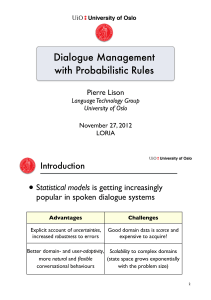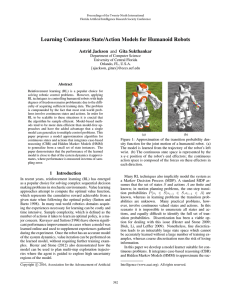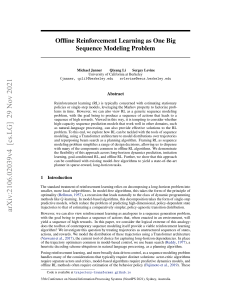• Towards Online Planning for Dialogue Management with Rich Domain Knowledge
advertisement
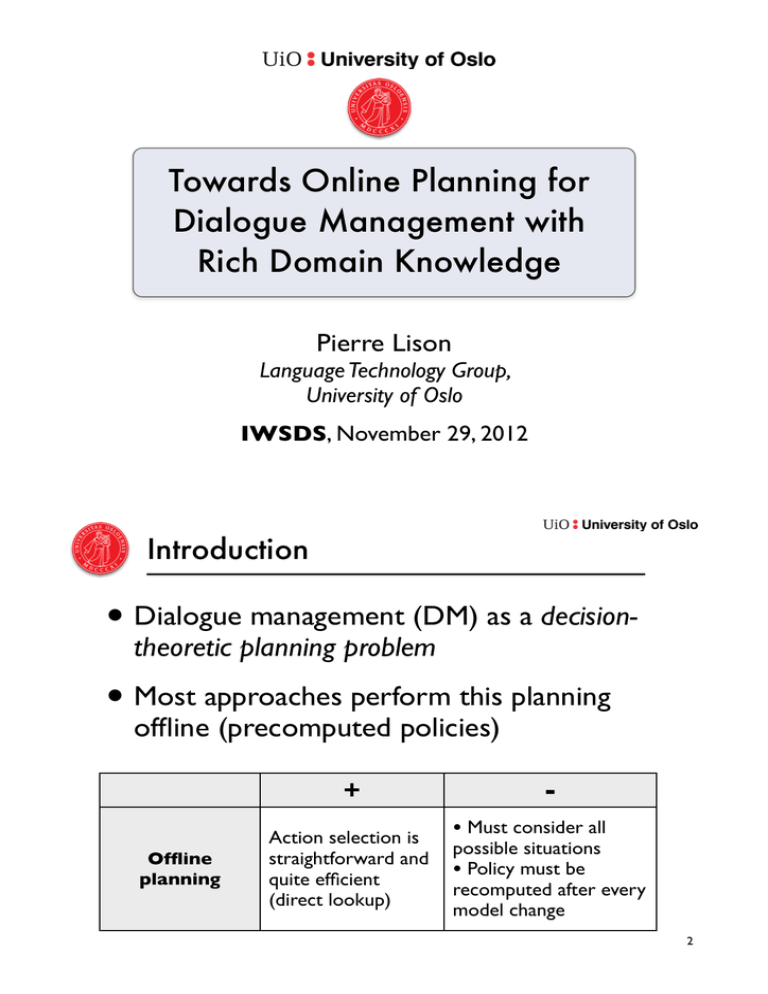
Towards Online Planning for Dialogue Management with Rich Domain Knowledge Pierre Lison Language Technology Group, University of Oslo IWSDS, November 29, 2012 Introduction • Dialogue management (DM) as a decisiontheoretic planning problem • Most approaches perform this planning offline (precomputed policies) + Offline planning Action selection is straightforward and quite efficient (direct lookup) • Must consider all possible situations • Policy must be recomputed after every model change 2 Introduction Alternative: perform planning online, at execution time + Offline planning Online planning Action selection is straightforward (and efficient) • Must only plan for current situation • Easier to adapt to runtime changes • Must consider all possible situations • Policy must be recomputed after every model change • Must meet real-time requirements 3 Approach • To address these real-time constraints, we must ensure the planner concentrates on relevant actions and states • Intuition: we can exploit prior domain knowledge to filter the space of possible actions and transitions • We report here on our ongoing work with the use of probabilistic rules to encode the probability/reward models of our domain 4 Approach • We represent the dialogue state as a Bayesian Network • Probabilistic rules are applied upon this dialogue state to update / extend it • Advantages: • • (exponentially) fewer parameters to estimate Can incorporate prior domain knowledge [Pierre Lison, «Probabilistic Dialogue Models with Prior Domain Knowledge», SIGDIAL 2012] 5 Probabilistic rules • The rules take the form of structured if...then...else cases, mappings from conditions to (probabilistic) effects: if (condition1 holds) then P(effect1)= θ1, P(effect2)= θ2 else if (condition2 holds) then • P(effect3) = θ3 For action-selection rules, the effect associates rewards to particular actions: if (condition1 holds) then R(actions)= θ1 6 Rule examples • Example r 1 (probability rule): if (am = AskRepeat) then am P(au’ = au) = 0.9 P(au’ ≠ au) = 0.1 r1 au • Example r2 (reward rule): if (au ≠ None) then a’u a’m au r2 R(a’m = AskRepeat) = -0.5 7 Approach • The transition, observation and reward models for the domain are all encoded in terms of these probability & reward rules • We devised a simple forward planning algorithm that: • • samples a collection of trajectories (sequence of actions) starting from the current state, until a specific horizon is reached • and records the return obtained for each trajectory The algorithm then searches for the action sequence with highest average return, and executes the first action in this sequence 8 Planning algorithm s0 a0m 0 R s1 au1 ... R1 a1m Loop (for each trajectory): Q=0 Loop (until horizon reached): Repeat Sample system action am until Q = Q + γtR enough trajectories Predict next state s are Sample next user action au collected Do belief update Record Q for trajectory ∀ trajectory, calculate average Q Return trajectory with max. Q until horizon is reached 9 Discussion • What is original in our approach? • The rules provide high-level constraints on the relevant actions (and subsequent future states) • For instance, if the user intention is Want(Mug), the rules will provide utilities for the actions PickUp(Mug) or AskRepeat, but will consider PickUp(Box) as irrelevant • In other words, they enable the algorithm to quickly focus the search towards high-utility regions • ... and discard irrelevant actions and predictions 10 Discussion • We did some preliminary experiments with an implementation of this algorithm • The rules did make a difference in guiding the search for «relevant» trajectories • But unfortunately, the algorithm doesn’t yet scale to real-time performance (sorry) • Need to find better heuristics to aggressively prune the applied rules, improve action sampling and the performance of the inference algorithm 11 Conclusions • Online planning can help us build more adaptive dialogue systems • Can be combined with offline planning, using a precomputed policy to guide the search of an online planner! • Using prior domain knowledge (encoded with e.g. probabilistic rules) should help the planner focus on relevant actions and filter out irrelevant ones • More work needed to find tractable planning techniques, and collect empirical results 12 13 Online reinforcement learning • Links with the reinforcement learning literature: • Our approach can be seen as a model-based approach to reinforcement learning, where a model is learned and then used to plan the best actions • Most other approaches rely on a model-free reinforcement learning paradigm, and try to learn the optimal action directly from experience, without trying to estimate explicit models (and plan over them) 14

